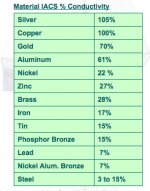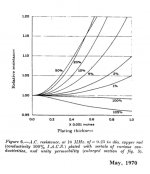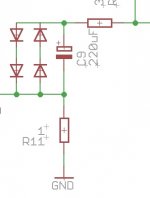Dario, what differences did you notice between 220uF and 470uF?
Sadly the 220uF was a BG FK and the 470uF a BG NX, so the difference was expected.
The bipolar NX sounded (sligthly) better, more refined.
Perhaps as Andrew T maintained all along, that really is the limiting factor for bass output of the MyRef. In that case, what hazards would a larger value pose to performance of the amp? Would there be any negative sonic impact? Does anyone use value other than 220uF, and what does that do to the bass?
No, I've asked directly to Mauro and the 220uF value it's a precise design choice and it not limits the bass response (Andrew pointed to a distortion difference, not bass response).
Somewhere on the design or alpha thread I've translated Mauro's answer.
Using a higher value should not harm but the more it differs from 220uF, the more you alter circuit response.
Alternate better connectors (yet to be tested for fit):
571-216843-1 (Phosphor bronze faston male PCB Connector)
571-42437-5 (Phosphor bronze faston female connector)
Very interesting. I have always been curious about phosphor bronze. I know that it is used for some very high quality connectors but its conductivity doesn't seem ideal.
I found this conductivity chart on a website.
http://www.diyaudio.com/forums/attachment.php?attachmentid=336921&stc=1&d=1363646764
And this graph in an old paper on plating for RF frequency conductivity.
http://www.diyaudio.com/forums/attachment.php?attachmentid=336922&stc=1&d=1363646764
It seems like the best conductivity over the AC frequency range would be a high conductivity core (like copper or silver) with a thin, low conductivity plating so that it wouldn't corrode. I am certainly missing something because phosphor bronze is definitely used in high end connectors.
Attachments
........... how low is too low? Dario, what differences did you notice between 220uF and 470uF? Perhaps as Andrew T maintained all along, that really is the limiting factor for bass output of the MyRef. In that case, what hazards would a larger value pose to performance of the amp? Would there be any negative sonic impact? Does anyone use value other than 220uF, and what does that do to the bass?
Peace,
Tom E
Great questions for the build/tuning of this newest version. Glad to have you back on board.
Very interesting. I have always been curious about phosphor bronze. I know that it is used for some very high quality connectors but its conductivity doesn't seem ideal.
(...)
I am certainly missing something because phosphor bronze is definitely used in high end connectors.
Bronze is considered better sounding than brass, soundwise, fuller and sweeter.
The only direct comparison between brass and bronze I've made is with the AC IEC inlet, the bronze one sounded fuller, sweeter, more natural.
But I don't have any scientific evidence for it.
Bronze is considered better sounding than brass, soundwise, fuller and sweeter.
Interesting. As I have come to understand, you can't explain everything with science.
I think it's important to make several FEs with different connections for different music
- brass if you listen to a lot of jazz and marching bands,
- copper if you lean toward kettle drums,
- silver if your daughter plays flute,
- nickel if your son plays bells in the percussion section,
and gold if you have more money than good sense.


Edit: bronze is only good for those who come in third !!!
- brass if you listen to a lot of jazz and marching bands,
- copper if you lean toward kettle drums,
- silver if your daughter plays flute,
- nickel if your son plays bells in the percussion section,
and gold if you have more money than good sense.
Edit: bronze is only good for those who come in third !!!
Last edited:
Boards shipped from manifacturer.
By the end of this week they should be in my hands
Very good news, bravo Dario
I think you will find that a very large cap will take longer to charge. It's only to a fews tens of mVdc but it is possible the cap will cause a very low frequency ripple on the output............. I wish I understood exactly what C9 does. If it only blocks DC, then how can the value ever get too big? Does using 470uF instead of 220uF make any sonic impact? If not, then why would 1000? .............
The speaker isolation will hide this if the FE can settle before the relay clicks over.
But that same VLF ripple could also occur if there was a quick change in input voltage.
Could someone try a 1mF in that position and report back?
Inverse parallel diodes solve this over-voltage during fault conditions.Jac, what you described apply on normal working conditions but C9, in theory, can be exposed to full rail voltage (35V) in case of failure.
Just recently (last week) I altered an old amp to a pair of series diodes in inverse parallel for a little extra voltage before the diodes conduct and a little less leakage across the diodes.
4off 1n4148 work and they don't take up much space across the pins of the DC blocking cap.
Boards shipped from manifacturer.
By the end of this week they should be in my hands
Dario,
Have you gotten any interest in the Elna RJH caps for C1 and C2? Personally, I am afraid to build an FE with a lesser cap because I'm afraid I will lose sound quality. I'm hoping there is enough interest from other builders that we could put an order together and, at least for me, jointly ship the boards and the caps.
Anybody else out there interested?
Jac
Inverse parallel diodes solve this over-voltage during fault conditions.
Just recently (last week) I altered an old amp to a pair of series diodes in inverse parallel for a little extra voltage before the diodes conduct and a little less leakage across the diodes.
4off 1n4148 work and they don't take up much space across the pins of the DC blocking cap.
Thanks Andrew. I didn't really understand the inverse parallel diode bridge before. This is a nice feature that would definitely add some safety. I like your extra diode tweak too.
Jac
Have you gotten any interest in the Elna RJH caps for C1 and C2?
Not so far... but the price can cover your order without problems.
Also until mid april there's no stock at Mouser of the MELF for R2, also a crtical part.
I can order them locally, for those interested, for 2.5€ (if quantity is enough price can be 1€ lower)
Let's investigate interest:
4 Elna RJHs -> 4.5€
2 CMA0204 for R2 ->2.5€
Both prices can go lower with quantity.
Inverse parallel diodes solve this over-voltage during fault conditions.(...)
4off 1n4148 work and they don't take up much space across the pins of the DC blocking cap.
Hi Andrew,
it seems an interesting idea, but I'm not sure I've understood how to implement it.. something like this?
Thanks in advance
Attachments
Boards shipped from manifacturer.
By the end of this week they should be in my hands
Good news Dario!
Thank you!
Not so far... but the price can cover your order without problems.
Also until mid april there's no stock at Mouser of the MELF for R2, also a crtical part.
I can order them locally, for those interested, for 2.5€ (if quantity is enough price can be 1€ lower)
Let's investigate interest:
4 Elna RJHs -> 4.5€
2 CMA0204 for R2 ->2.5€
Both prices can go lower with quantity.
People just add your names here
Pinnocchio
4x Elna RJHs -> 4.5€
2x CMA0204 for R2 ->2.5€
There are a dozen different 1/4W MELF resistors in stock at Mouser, many for pennies each, with quite decent tolerances, all the same dimension package (from what I can tell).
Is there a reason the specified resistor must be used? Must it be MELF? This loads the mute pin. Is there any signal passing through it?
Peace,
Tom E
Is there a reason the specified resistor must be used? Must it be MELF? This loads the mute pin. Is there any signal passing through it?
Peace,
Tom E
Put me downPeople just add your names here
Pinnocchio
4x Elna RJHs -> 4.5€
2x CMA0204 for R2 ->2.5€
Best
- Status
- This old topic is closed. If you want to reopen this topic, contact a moderator using the "Report Post" button.
- Home
- Group Buys
- My_Ref Fremen Edition Interest/Group Buy


